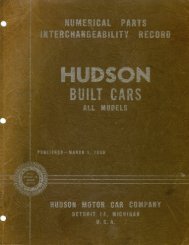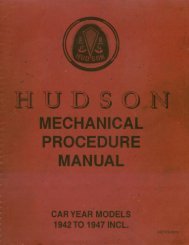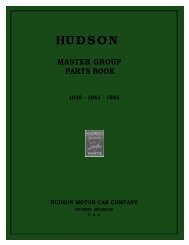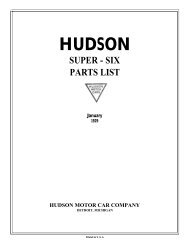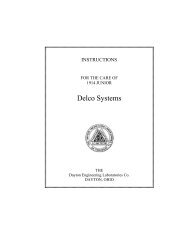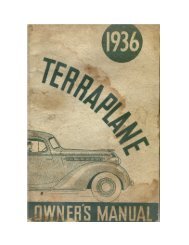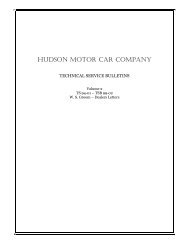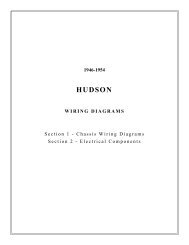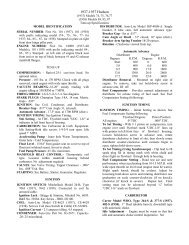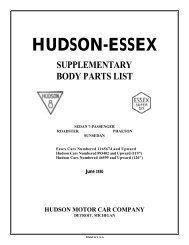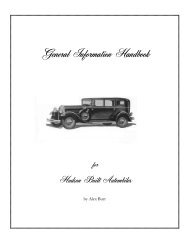1948-1952 Shop Service Manual - - Hudson-Essex-Terraplane Club
1948-1952 Shop Service Manual - - Hudson-Essex-Terraplane Club
1948-1952 Shop Service Manual - - Hudson-Essex-Terraplane Club
Create successful ePaper yourself
Turn your PDF publications into a flip-book with our unique Google optimized e-Paper software.
15 - 12 BRAKES<br />
3. Check linings for wear and loose rivets. Inspect linings for<br />
metal or foreign particles that may be imbedded in the<br />
surface and remove any that are found.<br />
Shoe and lining assemblies having linings soaked with<br />
lubricate or Hydraulic brake fluid should be replaced.<br />
They cannot satisfactorily be cleaned.<br />
NOTE: Use wheel cylinder clamp KMO-145 if brake<br />
shoes are to be removed. This clamp prevents the piston<br />
being forced out of the wheel cylinder either from the<br />
natural back pressure in the hydraulic system (combined<br />
with the spring pressure between the cups), or by an<br />
accidental movement of the brake pedal. Piston ejection<br />
would cause loss of fluid and allow air to enter the hydraulic<br />
system, necessitating bleeding the system.<br />
4. Inspect each drum braking surface and rebore the drum if<br />
necessary.<br />
Remove only sufficient metal to provide a smooth and<br />
true surface. If excess material is removed, the drum may<br />
be weakened to the extent that erratic braking and lining<br />
wear may result.<br />
5. Disconnect hand brake cables at the toggle (35) Figure 1.<br />
6. Thoroughly clean shoes and brake plates with a steel wire<br />
brush. All brake frictional points should be thoroughly<br />
cleaned after which a thin coat of lubriplate should b e<br />
applied at these points.<br />
7. Clean the exposed portion of all hand brake cables and<br />
then pull the cables through conduit from the wheel end<br />
to expose that part of cable that is sheathed by the conduit.<br />
Clean this portion of the cable and lubricate freely<br />
with viscous chassis grease. Figure 10.<br />
8. Push cable into conduit and after the shoes have been<br />
reinstalled, connect the cable to the shoe cable lever (5),<br />
Figure 1, leaving<br />
the adjustable yoke ends (25) of cables disconnected from<br />
toggle (35).<br />
9. To connect brake cable to shoe operating lever move<br />
cable return spring (12) away from cable end and place<br />
end into groove at the end of operating lever.<br />
After the cable is in place allow the cable return spring<br />
to return against the lever to hold the cable in place.<br />
10. Inspect backing plates for looseness and tighten if necessary.<br />
NOTE: When newly lined shoes are installed it will be<br />
necessary to back off on the adjusting screw to provide<br />
clearance for drum installation. After rear shoes are in<br />
place, attach the cable end to the rear brake lever, but do<br />
not connect front end of cable.<br />
11. Lubricate the front wheel bearings by applying a milled<br />
sodium soap base lubricant to the bearings and races<br />
only (3 ounces is sufficient).<br />
Excessive looseness at front or rear wheel bearings<br />
should be corrected.<br />
12. Before installing the front wheel hub and drum, remove<br />
any excess grease from inside the hub to prevent grease<br />
leakage onto the brake assembly.<br />
13. Check the level of lubricant in the rear axle housing. This<br />
should not be above the lower edge of the filler plug hole.<br />
Too high a level will cause lubricant leaks at the rear<br />
wheel oil seals.<br />
14. After installing hubs and drums, insert a pry between the<br />
linings of the secondary shoe and the drum (through<br />
drum feeler gauge hole) and move the shoe assembly<br />
until the primary shoe is against the opposite side of the<br />
drum, Figure 13. The primary shoe can be pried against<br />
the drum by inserting the .015" feeler gauge between the<br />
adjusting screw end of secondary



